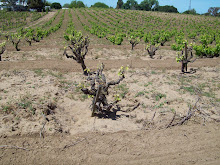
Kathy and I posted a while back about some Cline vineyard properties that are named after the Oakley streets to which they’re adjacent. Seeing old vines on Big Break Road made easy work of solving the mystery of where the grapes for Cline’s Big Break Zinfandel come from — no further questions, Your Honor.
Likewise their Bridgehead Road Zin probably was sourced from the old parcel on (dot, dot, dot) Bridgehead Road?
But the trippy thang is that both vineyard parcels were originally part of a huge agricultural land parcel bordered by Bridgehead Road to the west, and Big Break to the east, and purchased by chemical giant DuPont in 1955. Eighty-nine acres along Big Break were sold to Cline, as were 79 acres along Bridgehead, the two vineyards divided by tracks for the Santa Fe railroad.
But from 1956 until 1997, DuPont used virtually all the remaining acreage to erect a manufacturing base for the production of such agriculture-friendly goodies as anti-“pinging” gasoline additive tetraethyl lead; their patented refrigerant Freon; and the ever-popular white pigment, titanium dioxide.
Currently, with DuPont having shut down production years ago, and almost all manufactories on the site demolished, the vast property has been the target for myriad redevelopment plans with the City of Oakley, but the current economic climate seems to have stalled the dream.
Even trippier is a draft of something called the River Oaks Crossing Specific Plan, sponsored by the City of Oakley and the Oakley Redevelopment Agency, and which Kathy found online. Dated September 2007, this proposal provides a detailed blueprint for, basically, paving over the entirety of Cline’s old-vine Bridgehead Vineyard (acquired by the family when DuPont sold it) in favor of, among other mixed use, big-box retail: a Wal-Mart was said to be shovel-ready.
Man, between neighbors such as DuPont and Vold-Mart, I’m surprised that Cline’s Big Break Zinfandel didn’t glow in the dark, or exceed the RDA of lead in someone’s “Reedle” wine stemware from China.
Gawd, I need a drink.
And what better, this Memorial Day, than Cline’s 2006 Bridgehead Zinfandel from (insert Walter Brennan chuckle here) “the ol’ DuPont spread. Heh heh” ? It’s got a plumy garnet look, with a slight bluish tinge at the edge and a nose of blackberries, brambles and mocha. There are notes of earth and smoke, and a nice racy tartness on the back nine. “The miracles of science™,” indeed.









